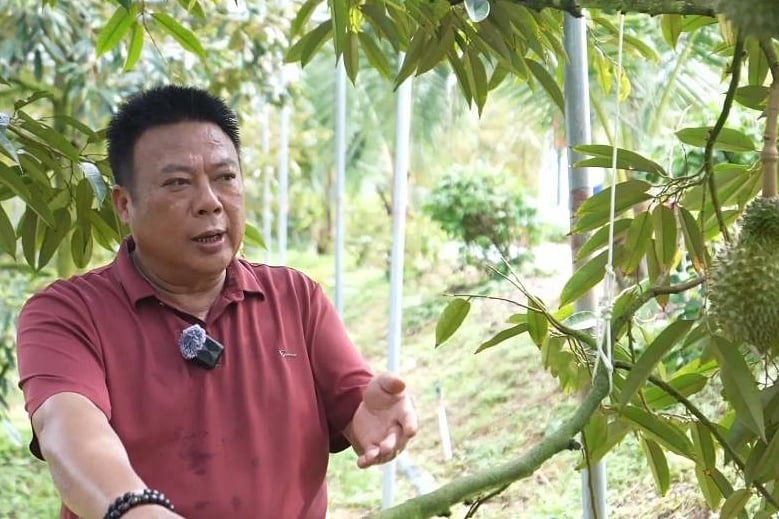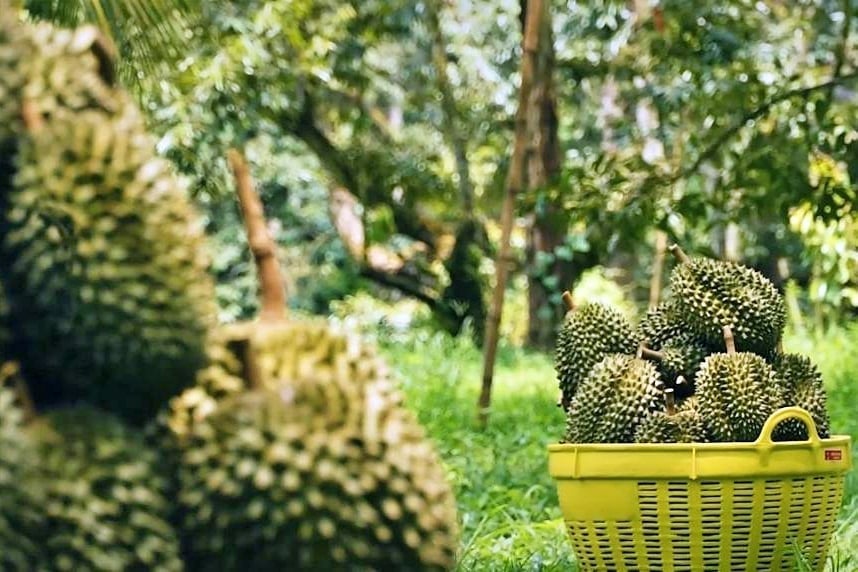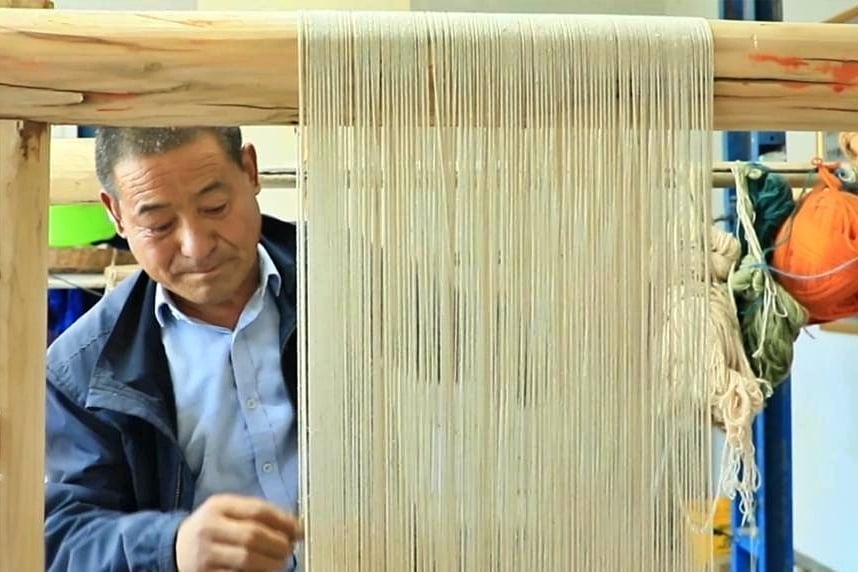October 26, 2025 | 11:56 GMT +7
October 26, 2025 | 11:56 GMT +7
Hotline: 0913.378.918
October 26, 2025 | 11:56 GMT +7
Hotline: 0913.378.918
“To see Hainan durian, you have to go to Sanya, and for Sanya durian, you have to come to the Yutai ecological region” – this saying is spreading across Hainan Island, where China is placing its bet on a fruit once emblematic of Southeast Asia: durian.
Under the scorching July sun, durian orchards in the Yutai ecological zone begin to release fragrance. The highest‑standard “tree‑ripened” fruit, once imported from Vietnam, Thailand, or Malaysia, is now grown right in China.

Farmer Deng Qichang is delighted with the tree‑ripened durians grown on Hainan Island. Photo: Xinhua.
Xinhua News Agency reports that with about 900 ha of durian planned, this region is witnessing the transformation of farmers like Deng Qichang, who had never seen a durian tree before, yet courageously cut down his mango orchard to start from scratch. What makes durian in Yutai particularly special is not just the cultivar or soil, but a combination of factors: from Hainan’s free trade policies and integrated irrigation‑fertilization systems to more than 160 quality monitoring indicators.
Thanks to advanced technology, the waiting time for trees to bear fruit has been halved, from about 8 years under traditional methods to 4 years, turning the tropical dream into a harvestable reality. To ease economic pressure during the early non‑fruiting years, locals interplant durian with banana, betel nut, or pineapple trees. Households and cooperatives participate in an enterprise‑cooperative‑farmer value chain linked with government seed capital and preferential policies from the Hainan Free Trade Port.
So far, Yutai ecological zone alone has attracted over CNY 4.5 billion in social investment and created jobs for over 4,000 workers.

Sanya durians are expected to offer Chinese consumers the "tree-ripened" experience with this high-value fruit. Photo: Xinhua.
Located on the Yunnan‑Guizhou plateau, Qingzhen city (Guizhou province) cannot grow durian, but it harbors another tropical dream, the heat of red bauxite ore. With reserves of over 300 million tons, accounting for about 10% of national resources, Guizhou holds one of the country’s largest aluminium treasures.
Since 2017, China Aluminum Company’s Guizhou branch has been operating large‑scale exploitation at the Maochang mine. Extraction technology has become increasingly advanced, safe and maximally efficient. Beyond raw mining, Qingzhen authorities are extending the value chain by inviting enterprises to engage in deep processing, from basic materials to high‑tech products.
For example, Guizhou Engraving Digital Technology Company, a high‑tech enterprise, supplies CTP printing plates to publishers in the Yangtze and Pearl River regions and exports to Southeast Asia and Europe. Similarly, Longshuo Company has invested over CNY 6 billion in a smart aluminium factory that produces electronic component casings, new energy vehicle parts, and prefabricated homes—all from what was once considered crude raw material.
From ore extraction to assembling tech products, a land once defined by mining dust is now part of the tropical transformation dream: green, smart and high‑value.
If Hainan is representative of tropical forests and Guizhou of a tropical stratum, then Qinghai – the cold land of the Tibetan Plateau – carries another kind of “tropicality”: the warmth of diligence and creative preservation.

Duyang Yongliang at the carpet weaving loom in Qinghai Province. Photo: Xinhua.
In the village of Giana, Shangxinzhang town, Huangzhong district, Xining city (Qinghai province), Mr. Yang Yongliang, the seventh generation of a Tibetan family of carpet weavers, continues to work at his loom. Tibetan carpet weaving has existed for thousands of years, once essential for resisting cold, and today has become a globally recognized cultural‑tourism‑economic product.
Transformed from a traditional craft, Tibetan carpets are now modernized. Shengyuan Company has built a digital design platform allowing customers to place personalized orders. Each carpet tells a story: from traditional patterns to new ideas, from highland colors to global visions. With over 1,600 designs and more than 2,000 patterns, a Tibetan carpet industrial cluster has emerged, combining design, production and commercialization.
Remarkably, despite changes in presentation, Tibetan carpets retain their soul: local wool, hereditary craftsmanship, and ethnic spirit. In China’s tropical dream full of innovation, there is room for even those crafts once thought dormant among the mountains.
When China grows durian, turns bauxite into tech materials, and brings handcrafted carpets onto digital commerce platforms, it is not merely about economic development; it is a process of redefining tropical products.
In the era of globalization, “tropical” in China’s dream is no longer a geographic or climatic category, but a symbol of new energy, innovation, and the ability to master what once belonged to others.
With tree‑ripe durians on Yutai soil, the tropical belt is moving gradually northward. Not because the Earth is heating up, but because human hands are reaching further.
In 2024, China imported a record 1.56 million tons of durian, valued at nearly USD 7 billion, an increase of 9.4% in volume and 4% in value compared to 2023. Vietnam alone exported about 730,000 tons to China, accounting for over 40% of the market share, second only to Thailand.
Sanya durian, especially tree‑ripe types, though still small in acreage relative to the enormous national demand, is beginning to attract attention thanks to its unique domestic fruit quality: rich flavor, distinctive aroma and no freezing processes. While the domestic market remains heavily reliant on imports, Xinhua News Agency assesses that Sanya production now represents a significant step in localization.
Translated by Huong Giang

(VAN) Building on its leading position, Ho Chi Minh City drives a green, digital, and creative wood industry toward global reach and its goal of joining the world’s top 100 most livable cities by 2045.
/2025/10/25/0325-1-nongnghiep-130321.jpg)
(VAN) The 2024–2025 crop year of Viet Nam's coffee industry has ended with record export turnover of USD 8.4 billion. Since the beginning of this year, exports have already surpassed USD 7 billion.

(VAN) Vietnam and Chile are seeing opportunities to deepen their agricultural cooperation, especially as both share a common vision of sustainable development and trade integration.

(VAN) Strong export growth across industries drives Phu Tho’s economic breakthrough and contributes to achieving overall growth goals.

(VAN) During the first 7 months of 2025, Russia boosted its share of Chinese poultry imports to a record 18%, up from 14% the previous year.

(VAN) By October, fruit and vegetable export turnover is estimated to exceed 7 billion USD. This marks the second consecutive year that the sector has surpassed this milestone.

(VAN) Mr. Hamish Marr, New Zealand’s Special Agricultural Trade Envoy, shares experience in developing sustainable, transparent, and value-added agricultural export chains.